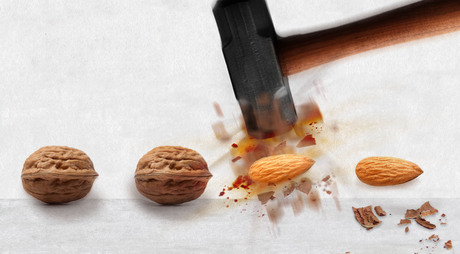World's most powerful X-ray creates a new type of crystal

An international team of scientists has inadvertently discovered how to create a new type of crystal using light more than 10 billion times brighter than the sun, reversing what has been accepted thinking in crystallography for more than 100 years.
The discovery occurred when the scientists exposed a sample of crystals, known as Buckminsterfullerene or Buckyballs, to intense light emitted from the world’s first hard X-ray free electron laser (XFEL), based at Stanford University in the US. Light from the XFEL is around one billion times brighter than light generated by any other X-ray equipment — even light from the Australian Synchrotron pales in comparison.
Because other X-ray sources deliver their energy much slower than the XFEL, all previous observations had found that the X-rays randomly melt or destroy the crystal. The scientists had previously assumed that XFELs would do the same. The results, however, were not what they expected.
When the XFEL intensity was cranked up past a critical point, the electrons in the Buckyballs spontaneously rearranged their positions, changing the shape of the molecules completely. Every molecule in the crystal changed from being spherical, like a soccer ball, to being shaped like an AFL ball. This effect also altered the sample’s optical and physical properties.
“We were stunned,” said Associate Professor Harry Quiney, from the University of Melbourne. “This is the first time in the world that X-ray light has effectively created a new type of crystal phase.
“Though it only remains stable for a tiny fraction of a second, we observed that the sample’s physical, optical and chemical characteristics changed dramatically from its original form.”

“It was like smashing a walnut with a sledgehammer, and instead of destroying it and shattering it into a million pieces, we instead created a different shape — an almond!” added Associate Professor Brian Abbey, from La Trobe University.
The team’s results have been published in the journal Science Advances and are said to be pushing the 100-year-old science of crystallography in “a new, exciting direction”, according to Associate Professor Abbey.
“Currently, crystallography is the tool used by biologists and immunologists to probe the inner workings of proteins and molecules — the machines of life,” he said. “Being able to see these structures in new ways will help us to understand interactions in the human body and may open new avenues for drug development.”
'Phantom chemical' in drinking water finally identified
Researchers have discovered a previously unknown compound in chloraminated drinking water —...
Flinders facility to use the micro realm to understand the past
AusMAP aims to revolutionise the ways scientists address key questions and grand challenges in...
A new, simpler method for detecting PFAS in water
Researchers demonstrated that their small, inexpensive device is feasible for identifying various...



